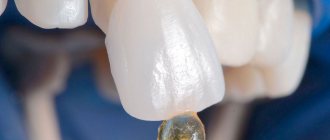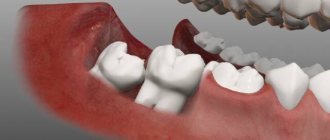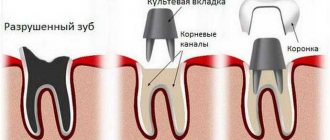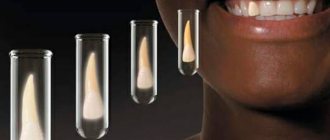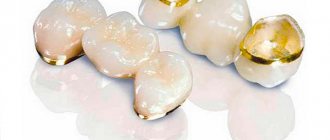A 25-year-old young man came to the clinic with complaints about a yellowed filling, an unaesthetic smile due to a damaged front tooth, and his sensitivity to hot and cold food.
Duration of treatment
1,5 hour
| Treatment of deep caries | RUB 7,500 |
Photo before treatment.
During the initial examination, secondary deep caries, loss of fillings, and darkening of the enamel were detected. An X-ray examination did not reveal pulpitis; tooth depulpation is not necessary. This is important because the “living” tooth has nutrition and will last longer, even with restoration of the crown part.
Since external aesthetics plays an important role in the reconstruction of anterior teeth, together with the patient it was decided to install fillings made of light-curing photopolymer.
Photopolymers are modern materials that have a rich palette of shades, which the dentist can choose exactly to match the “native” teeth. In addition, they are cured under the influence of a special lamp, remaining plastic for a long time. Therefore, the dentist can artistically recreate the original shape, ideal surface and points of contact with neighboring teeth.
If additional treatment is not needed, restoration of anterior teeth with filling material is carried out in one visit for no more than 40-60 minutes.
Types of fillings
When visiting a dentist, your doctor may offer fillings made from various materials. The most common are the following:
- Cement. They have excellent strength, but do not differ in aesthetics.
- Composite. The most aesthetic option, but the strength leaves much to be desired.
- Light. The most popular fillings that harden by polymerization with a blue lamp.
- Plastic. Such fillings darken very quickly and are clearly not suitable for the restoration of front teeth.
Sealing
Using a special Vita dental color scale, together with the patient, the desired shade of Estelite Asteria, a light filling for the front teeth, was selected. Estelite Asteria is a modern nanohybrid composite that combines the properties of macro- and microparticles. Estelite Asteria also has a color chameleon effect that blurs the boundaries between the filling and healthy areas of the enamel. So, only she and the treating dentist will know about the presence of a light filling in the patient’s mouth.
The doctor applies the photopolymer in layers, carefully restoring the shape of the damaged tooth. Then each layer is illuminated with an ultraviolet lamp for a certain time until it hardens.
For a natural positioning of the lateral surfaces in relation to adjacent teeth, a matrix is used. This device helps give the filling a physiological shape and correctly form the interdental space. To prevent the interdental space from becoming too wide, a wooden or plastic wedge is placed between the diseased tooth and the neighboring one, moving it back a fraction of a millimeter. In its place, a gingival papilla will subsequently form. After performing manipulations to create a tooth shape from light-curing materials, the wedge and matrices are removed.
Which one is better to choose for the smile area?
If you are thinking about which option to choose for dental restoration, the best option in terms of price and quality is a light filling. It has a number of positive aspects:
- There is no need to wait two hours to eat and drink after a dental procedure.
- It is characterized by high strength and a longer service life. On average, a light filling lasts up to 7 years.
- Absolute safety for the body.
- It is possible to choose the color of the seal so that the restored unit does not differ from the rest.
Prices
| Consultations and inspection | |
| Initial consultation with a dentist and development of a treatment plan | from 500 0 rub. |
| Examination by a doctor with issuance of a certificate of oral health | 1,000 rub. |
| Veneers | |
| Composite restoration veneer “Esthet-X” | from 8,500 rub. |
| Ceramic veneer EMAKH | from 25,000 19,900 rub. |
| Temporary veneers | 3,500 rub. |
| Diagnostics | |
| X-ray of teeth | 300 rub. |
| Sight shot of teeth | 300 rub. |
| Panoramic photograph of teeth (orthopantomogram) | 1,000 rub. |
| Anesthesia | |
| Infiltration anesthesia | 450 rub. |
| Conduction anesthesia | 600 rub. |
Preparatory measures
First, the dentist will have to visually examine the defect in the front tooth. If your teeth have decay, you may need to take x-rays. In particularly difficult cases, the nerve may need to be removed. Of course, this happens under the influence of a high-quality anesthetic.
If there is no caries, and the reason for the visit to the dentist is a chipped front unit, then the enamel is cleaned of plaque and tartar is removed. Next comes the filling process itself.
For what dental diseases is filling used?
Tooth enamel is the hardest tissue in the body and can withstand loads of up to 400 kg. However, insufficient oral hygiene, consumption of excessive amounts of sweets, smoking, coffee, as well as genetic predisposition can lead to destruction of the integrity of the enamel. This process is called caries.
Depending on the depth of the lesion, caries can be:
- Initial caries - when there is no damage to the tooth enamel, except for a matte white spot. The reason for its appearance is the loss of minerals: calcium and fluoride. In this regard, the permeability of the enamel increases, so the color of the stain may change over time to dark brown and even black.
- Superficial caries is a stage that is already characterized by physical damage to the enamel, but only within its limits.
- Medium caries - characterized by deeper damage to tooth tissue. The destruction extends beyond the enamel and reaches the dentin zone.
- Deep caries is the most complex form of destruction of hard tooth tissues. The affected area reaches the area close to the pulp (nerve). At this stage there is a high risk of infection and inflammation.
Most often, caries develops in areas that are most difficult to clean. As a rule, these are interdental spaces and natural depressions in the tooth (fissures). Since there is practically no pain, and there are no significant visible changes, for a long time a person does not suspect the presence of caries. During this time, caries can go through all stages and by the time you contact a doctor, a significant part of the tooth will already be destroyed.
To prevent this from happening, it is necessary to undergo preventive examinations with a dentist every six months.
How does the installation work?
- Using a drill, the tooth is slightly ground down for better adhesion of the filling to the tooth.
- Thorough treatment with antiseptic drugs.
- Applying a special filling substance to the tooth, evenly distributing the composition.
- Polymerization using a blue lamp.
- At the end of the procedure, sanding and polishing are carried out to make the unit as similar as possible to the rest.
On average, installing a light seal will cost 4-7 thousand. Some clinics often hold promotions, thanks to which you can restore a tooth at a reduced price.
What is a light or reflective seal?
So, a light filling (photopolymer, light-polymer, reflective, polymer, light-hardening, etc.) is considered one of the highest quality and most durable materials. However, its main advantage is its high aesthetics. It is almost invisible on the teeth and can be used to correct the frontal area.
Many people ask the question: “What is the difference between a light filling and a regular one?” In fact, the main difference between these two materials is the speed of hardening. For example, if a photopolymer filling hardens under the influence of ultraviolet radiation within a few seconds, then in order for the chemical material to acquire the necessary hardness, you need to wait 2 hours until its components react. That is why a light-curing filling or light-curing filling is optimal for high-quality and aesthetic dental restoration.
The most important advantage of a light filling is the variety of its color tones. This allows you to select the exact color that fully matches the natural shade of the patient’s tooth enamel in each individual case.
[]
Should I turn to free healthcare?
The filling is installed not only in private clinics, but also in public clinics. In such institutions you can get a filling at a very low price or completely free of charge. However, the quality of such restoration leaves much to be desired. This is due to several factors:
- Government institutions save as much as possible on everything. For this reason, a minimum number of tools and consumables will be used during the installation of the filling.
- Fillings in free institutions are of the lowest quality. Accordingly, the result and service life are minimal.
- There may be very painful sensations, since low-quality anesthetics are used during the work.
Restoration of anterior teeth using filling material is a budget-friendly way to restore aesthetics and chewing function. Contact only trusted doctors so as not to be disappointed with the result.
Other indications for replacing an old filling
Subsidence of the filling . Over time, the material from which the filling is made shrinks (vertical and horizontal).
When the filling subsides vertically, the height of the bite changes, which can cause dysfunction of the temporomandibular joint. In addition, the shrinkage of the filling changes the height of the contact point between the antagonist teeth (teeth of the upper and lower jaw). And since the teeth experience a lot of stress during the process of chewing food, constant pressure can cause the defective filling to collapse, and along with it, part of the tooth.
When the filling shrinks horizontally, the contact point (point of contact) between adjacent teeth disappears. While eating, food gets stuck between the teeth and constantly injures the interdental (dental) papilla. The gums become inflamed, gingivitis, periodontitis and secondary caries develop.
Overhanging edges of the filling. This defect occurs if the filling material flows onto the gum (rests on it). The overhanging edge of the filling leads to permanent injury to the gums and causes inflammation. Often such a filling causes local periodontitis (periodontitis in the area of one tooth) and secondary caries, since it is impossible to remove food debris from the resulting pocket.
The contact point is formed correctly if the dental floss (floss) forcefully penetrates the gap between the teeth, moves freely along the side surface of the tooth (does not cling to irregularities) and is pulled out with force.
Another reason for replacing an old filling is the incorrect anatomy of the chewing surface of the tooth. Most often this is a consequence of poor quality treatment. The surface of an old filling may be almost smooth and lack pronounced bumps and fissures.
The correct shape of the tooth surface provides not only an aesthetic appearance, but also the performance of chewing functions. The lack of a natural pattern on the chewing surface of the teeth does not allow for effective grinding of food and leads to gastrointestinal diseases.
When biting and grinding food, the teeth experience a heavy chewing load. In order for the antagonist teeth to connect into the correct bite and not experience strong friction against each other, they must touch at points of a small area.
The correct connection to the bite is determined, among other things, by the shape of the surface of the teeth. To create such a surface, a dentist must have a good knowledge of the anatomy of teeth and possess the skill of a sculptor.
You can also replace an old filling with a new one for aesthetic reasons. Over time, teeth and fillings will change color; this discrepancy may also be a reason to replace the filling.
Restoration of chewing teeth using a filling
The need for restoration may also arise when it comes to the restoration of chewing teeth. In this case, other tasks will be relevant. In particular, the function that needs to be restored becomes important. It is necessary that such a tooth can withstand significant loads. It is especially important that the material does not wear out.
Affordable price is also of great importance. And we must not forget about the condition of the tissues surrounding the chewing tooth: after all, we are talking about a large molar. And if he was struck by caries, then the inflammatory process could be directed to the roots of other teeth, as well as to the gums. Therefore, in this case, our doctors pay great attention to diagnosis, doing everything to find the slightest signs of inflammation.
What manufacturers' fillings do we use?
- Charisma is a German material with the smallest particle size, a high degree of adherence and a smooth surface.
- Filtek is a composite of the American company 3M ESPE, has high strength, 35 shades, and is close in physical properties to tooth tissue.
- Estelite is a Japanese material, resistant to staining, bacteria, abrasion like natural teeth.
- Esthet-X is a composite from the DENTSPLY brand (USA/Switzerland), suitable for any restoration, characterized by resistance to chipping and durability.
Making an appointment does not oblige you to anything, you can cancel your appointment at any time
Make an appointment
If a temporary filling falls out
This filling is especially important if medication is placed in the tooth. It is the seal that fixes it in the right place. If the filling falls out before the time prescribed by the doctor, this is fraught with unpleasant consequences. The drug may have a negative effect on enamel and soft tissues. Therefore, such fillings should be treated with the utmost care, without overloading the tooth. If material falls out, you should consult a doctor immediately.
If the temporary filling simply covered the cavity after root canal treatment, until your next visit to the dentist you should refrain from chewing on this tooth, gently rinse your mouth and brush your teeth carefully.


